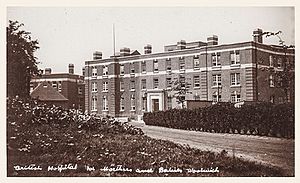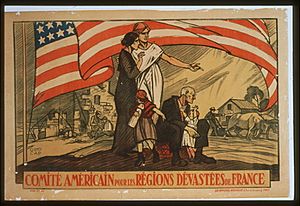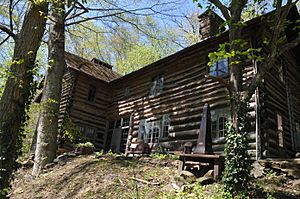Mary Carson Breckinridge facts for kids
Quick facts for kids
Mary Carson Breckinridge
|
|
|---|---|
 |
|
| Born | February 17, 1881 |
| Died | May 16, 1965 (aged 84) |
| Known for | Founding the Frontier Nursing Service |
| Medical career | |
| Profession | Nurse midwife |
Mary Carson Breckinridge (born February 17, 1881 – died May 16, 1965) was an American nurse midwife. She started the Frontier Nursing Service (FNS). This service gave complete medical care to families in the mountain areas of rural Kentucky.
The FNS helped people in faraway, poor areas. These places were hard to reach by roads or trains. Nurses traveled there on horseback. Mary Breckinridge based her ideas on health services she saw in Europe. She wanted to make nurse-midwives in America highly skilled. This way, they could work on their own in homes and small clinics. Her work greatly lowered the number of babies and mothers who died in the Appalachian Mountains. This was done at a low cost.
Contents
Mary Breckinridge's Early Life
Mary Breckinridge was born on February 17, 1881, in Memphis, Tennessee. She was the second of four children. Her family was wealthy and well-known in the South. Her grandfather, John C. Breckinridge, was a Vice president of the United States. Her father, Clifton R. Breckinridge, was a Congressman from Arkansas. He also served as the U.S. Minister to Russia.
Because of her family, Mary grew up in many different places. These included large homes in Mississippi, Kentucky, and New York. She also lived in Washington, D.C. and St. Petersburg, Russia. She went to schools in Lausanne, Switzerland, and Stamford, Connecticut. These experiences helped her later in life. She learned to speak in public and met many important people. These people later helped her raise money for her work.
Mary was not happy that her older brother got a better education. He went to private schools. She and her sister were taught at home by tutors. Still, she learned a lot from her private tutors in Washington, D.C., Switzerland, and Russia.
Some childhood events helped Mary prepare for her career. She wanted to help families stay healthy. She also believed in continuous care for mothers and children. This included good food, shots, care before birth, help during birth, and check-ups after birth.
In 1894, Mary and her family moved to Russia. Her father was appointed the U.S. minister there. They came back to the United States in 1897. Mary was 14 when her younger brother was born in Russia. She saw a trained midwife, Madame Kouchnova, lead the birth. This event was very important for her future ideas about the Frontier Nursing Service.
Mary's mother had a fever after Mary was born. So, Mary was fed by a wet nurse and goat milk. When Mary was young, she spent summers at Hazelwood, a country house in New York. This was with her great aunt, Mrs. James Lees. Her great aunt, called "Grandmother Lees," used her money to educate children in the South, especially in Kentucky. Mary later used money she inherited from Grandmother Lees to start the Frontier Nursing Service.
Mary also visited the Oasis Plantation in the Mississippi Delta. There, she learned to ride horses at a young age. This skill was very important for the nurse-midwives of the Frontier Nursing Service. They traveled by horseback to reach people.
Marriage and Family Life
In Mary Breckinridge's time, women were mainly expected to be wives and mothers. But she became famous for starting the Frontier Nursing Service. Her work helped many people in rural Kentucky.
In 1904, when she was 23, Mary married Henry Ruffner Morrison. He was a lawyer from Hot Springs, Arkansas. He died in 1906 from problems with appendicitis. They did not have any children.
In 1912, she married Richard Ryan Thompson. He was from Kentucky and was president of a college in Eureka Springs, Arkansas. Before having children, Mary taught French and hygiene at the college. These teaching experiences helped her later work in France.
Mary and Richard had two children. Their daughter, Polly, was born too early in 1916 and lived only a few hours. Their son, Clifford Breckinridge Thompson, was born in 1914. He died just two years after his sister. After losing her husband and two children, Mary decided to dedicate her life to helping children and families.
Mary left her second husband in 1918. Their divorce was final in 1920, and she started using her maiden name again.
Mary Breckinridge's Education and Training
Mary Breckinridge was taught at home by governesses and tutors when she was young. She then went to a boarding school in Lausanne from 1896 to 1897. The goal was for her to learn to speak and write well for marriage. She learned French and studied history and literature. This time in France and the Swiss Alps helped her later. It prepared her to manage a nursing program in France after World War I. It also made her love mountains, like the Scottish Highlands and the Appalachian Mountains.
She finished her schooling at Miss Low's School in Stamford, Connecticut. After her first husband died, Mary went to nursing school. She studied at St. Luke's Hospital of Nursing in New York for three years. She graduated in 1910 and became a registered nurse.
After her children died and her second marriage ended, she worked in Washington, D.C.. She supervised nurses during the 1918 flu outbreak. Before going to Europe, Mary took a short course in baby welfare in Boston. She worked in poor areas there.
Mary spent three years with the American Committee for Devastated France. This experience helped her plan a public health system for rural Kentucky. Nurse-midwives would be at the center of this system. To make her plan, she took several important steps:
- She took advanced courses in public health nursing at Columbia University. She learned about statistics, child psychology, and biology.
- In the summer of 1923, she rode a horse over 650 miles through Kentucky. She studied the local midwives, who were about 60 years old. She found some were good, but many used old, unclean methods.
- There were no midwifery courses in the United States at that time. So, Mary went to England in the fall of 1923. She trained at the British Hospital for Mothers and Babies. After a four-month course, she became a certified midwife.
- After her midwifery training, Mary went to Scotland in 1924. She looked at health services in remote areas. She toured Scotland's public health system. The Highlands and Islands Medical and Nursing Service became her model for the Frontier Nursing Service. This system was spread out and worked together. It got money from private and public sources. Nurses were trained in public health, district nursing, and midwifery.
- Finally, she went back to London for more midwifery study. The Queen's Institute of District Nursing had a very low maternal death rate.
Mary Breckinridge returned to Kentucky with the education and experience she needed. She was ready to create the Frontier Nursing Service.
Helping France and Learning for Kentucky
At the end of World War I, Mary Breckinridge worked for the Children's Bureau. She wrote reports on child welfare in different states. She also gave speeches to support children.
After the war ended, Mary volunteered for the American Committee for Devastated France. Her group helped bring back food, seeds, and medicine. She focused on children under 6 and pregnant mothers. She cared for patients with many illnesses. She also helped children who were not getting enough food. Many families had been through a lot during the war.
Mary wrote many letters home to her mother. In one letter, she said how much families would benefit from goat's milk. Her mother helped organize people to donate money for goats. Mary thanked the donors and shared stories of the children they helped. She also asked for more money to feed the goats. More and more people helped.
The American Committee for Devastated France also started to rebuild the public health system. Mary played a key role in this. She studied the old system to imagine a new one. She created the Child Hygiene and Visiting Nurse Service. This service sent nurse-midwives to the countryside. It became a service that helped people of all ages.
Mary kept detailed records of her work. She saw that the idea of small, spread-out clinics could work in other rural areas. She would use these ideas for her Frontier Nursing Service.
Mary knew that trained nurse-midwives were needed. She visited facilities in London and saw how English nurse-midwives worked. She realized that the United States trained nurses but not midwives. France trained midwives but not nurses. England trained nurse-midwives, who would be best for rural areas. Mary planned to start a nursing school in France. Although this plan didn't happen, she learned a lot. This knowledge helped her create the Frontier Nursing Service when she returned to the United States in 1921. Her mother died a month later.
A New Way to Provide Healthcare
In Europe, Mary met French, English, and Scottish nurse-midwives. She realized that people with similar training could help mothers and babies in rural America. She found her best model in Scotland's spread-out health system.
Mary also studied the "granny-midwives" in Leslie County, Kentucky. She understood what rural Kentucky families truly needed. She knew that trained nurse-midwives were essential. Mary came from a wealthy family, but she often helped people living in poverty. She wanted to follow her Grandmother Lees' example of helping children in need. Mary was a very religious woman and felt this work was her life's purpose.
Mary returned to the U.S. in 1925. On May 28, she founded the Kentucky Committee for Mothers and Babies. This soon became the Frontier Nursing Service. It offered general health care, shots, care before and after birth, and birth services. Two midwives she met in London, Edna Rockstroh and Freda Caffin, joined her.
Mary, her father (who took care of the horses), and nurses Edna and Freda set up the first clinic in 1925. They lived together in Hyden, Kentucky. There were no good roads, so the nurses rode horses for transportation. The FNS showed that well-trained midwives could lower the death rates of mothers and babies. They delivered their first baby in September 1925. The nurses rode horses day and night, in all kinds of weather, to deliver babies.
Mary worked with Ann MacKinnon to create the Kentucky State Association of Midwives in 1930. Mary used her own inheritance and many donations to start The Frontier School of Midwifery and Family Nursing. This was the first school of its kind in the U.S.
Mary had a large log house, called the Big House, built in Wendover, Kentucky. This served as her home and the Frontier Nursing Service headquarters. In 1939, she started her own midwifery school there.
Mary continued to lead the Frontier Nursing Service until she died on May 16, 1965, in Wendover. When she died, the FNS had helped almost 58,000 patients. They had delivered over 14,500 babies. Only 11 mothers had died during birth.
Mary Breckinridge's nurse service showed that trained nurses could greatly reduce deaths of mothers and babies. Even though doctors sometimes disagreed, her work led to the creation of the Frontier Nursing University. This university still trains professional nurse-midwives today.
Honors and Recognition
Mary Breckinridge received the Medaille Reconnaissance Francaise. This was for organizing a visiting nurse association in France. In 1952, the Kentucky Press Association named her Kentuckian of the Year. In 1995, she was added to the National Women's Hall of Fame.
In 1998, the United States Postal Service honored her with a 77¢ postage stamp. In 2010, a statue of Mary Breckinridge on horseback was placed in Hyden, Kentucky.
See also
 In Spanish: Mary Carson Breckinridge para niños
In Spanish: Mary Carson Breckinridge para niños




